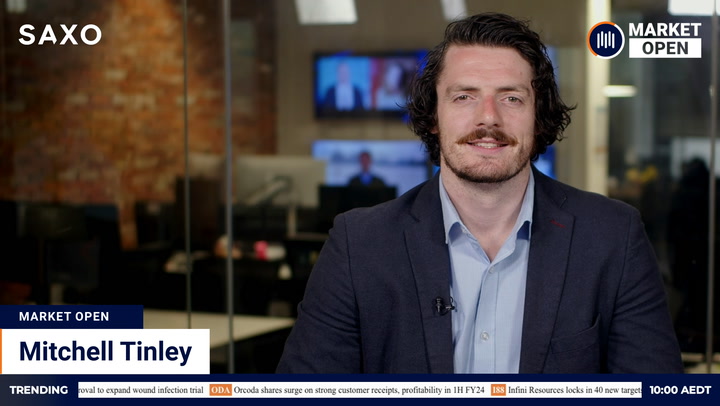Australia’s mining-heavy share market was set to open cautiously higher as investors weighed Wall Street’s best night in a year and a half against steep declines on commodity markets.
ASX futures firmed 27 points or 0.38 per cent as the S&P 500 surged almost 2.5 per cent. The Dow put on more than 600 points and the Nasdaq Composite 3.4 per cent.
The outlook for the day was tempered by a double-digit collapse in crude and setbacks for iron ore, wheat and metals.
Wall Street
US stocks surged as hopes for a diplomatic breakthrough in the Ukraine war helped cool red-hot commodity prices. Crude oil tumbled on reports some OPEC producers support increasing production to offset Russian shortfalls.
The S&P 500 soared 102 points or 2.45 per cent, its biggest gain since June 2020. The Dow Jones Industrial Average put on 633 points or 1.94 per cent. The Nasdaq Composite charged up 438 points or 3.42 per cent.
Earlier, European markets bounced up to 8 per cent on news Ukraine had backed away from insisting on NATO membership. The issue was one of Russia’s stated reasons for invading.
Other reports suggested Ukraine President Volodymyr Zelensky was looking for a diplomatic solution after two weeks of fighting. The speculation came as the foreign ministers of Russia and Ukraine prepared to meet tonight in Turkey.
Crude oil plunged following media reports Iraq and the United Arab Emirates were keen to increase production to replace Russian supply affected by embargoes. Brent crude settled US$16.84 or 13.2 per cent lower at US$111.14 a barrel. The US benchmark dived US$15 or 12.1 per cent to US$108.70.
Surging energy prices helped push the Dow and S&P 500 into technical corrections this week and the Nasdaq into a bear market.
“The equity market continues to take its cues from changes in commodity prices, namely oil,” Kathy Bostjancic, chief US economist at Oxford Economics, said.
“Trading will continue to be volatile and rally when prices retreat, but overall the prospect of oil and non-energy prices remaining very high casts a cloud overall the outlook for economic activity and the equity market.”
Big Tech rebounded even as long-term lending costs increased. Netflix gained 4.98 per cent, Microsoft 4.59 per cent and Alphabet 4.97 per cent.
Lenders were lifted by improved yields as investors rotated out of bonds into riskier assets. Wells Fargo gained 5.77 per cent, Bank of America 6.35 per cent and Goldman Sachs 3.83 per cent.
Beaten-up travel stocks rebounded. United Airlines bounced 8.27 per cent. Cruise line Carnival gained 8.75 per cent. The sector had fallen heavily over the last week on the prospect of higher costs and weaker demand as surging fuel costs left consumers with less disposable income.
This year’s standout sector, energy, skidded 3.18 per cent. Exxon Mobil sank 5.68 per cent and Chevron 2.5 per cent.
In Europe, the pan-European Stoxx 600 surged 4.68 per cent. Germany’s DAX index jumped 7.92 per cent. France’s CAC 40 put on 7.13 per cent.
Australian outlook
Futures action suggests down-pressure from the energy and materials sectors will temper improvements elsewhere. The ASX’s heavy bias towards commodities protected the local market from the worst of the global sell-off, but will prove a handicap on the way back up.
The S&P/ASX 200 pre-empted some of the overnight strength with a rise of 73 points or 1.04 per cent yesterday. Risk appetite was back, with growth and speculative stocks outperforming the wider market. That all bodes well for the session ahead.
Investors can take hope from the fact the US materials sector held up well overnight. The sector rallied 3 per cent, placing it in the top third.
Index heavyweights BHP and Rio Tinto cruised through the storm. BHP‘s US-traded depositary receipts rallied 0.39 per cent after its UK listing dipped 1.1 per cent. Rio Tinto gained 0.25 per cent in the US after losing 1.19 per cent in the UK.
Technology and financials topped the US sector list, both adding more than 3.6 per cent. Energy was the only major loser, falling 3.18 per cent. Utilities and consumer staples made up the bottom three.
“The rally on Wall Street overnight means the conditions are ripe for tech stocks to perform well again today. But we really cannot say the same for energy stocks following the drubbing of oil prices overnight,” City Index senior market analyst Matt Simpson said.
“Murphy’s law is all around us, and markets are no exception. No sooner than we saw an influx of ‘oil is headed for $200’ headlines, WTI rolled over to close around -12% lower. But it could have been worse, as the session low was around -22% which had in on track for a technical bear market in a single day. Nice one Murphy.”
Whether this week marks a market bottom remains to be seen. Extreme gains of the scale seen overnight are no more the mark of a healthy market than the extreme declines seen earlier this week. Sentiment remains tied to developments in Ukraine and their knock-on effect on commodity markets.
Back home, monthly building approvals data were scheduled for release at 11.30 am AEDT.
The dollar bounced 0.86 per cent to 73.3 US cents.
Commodities
The collapse in crude set the tone for a tough night on commodity markets. Heating oil tanked 21.9 per cent in the US, the biggest fall since 1991. Gasoline prices slumped 10.6 per cent. The Bloomberg commodity index shed 7.19 per cent.
Industrial metals reversed sharply on the London Metal Exchange. Benchmark tin slumped 17.6 per cent to US$40,375 a tonne. Zinc dived 9.66 per cent, aluminium 5.33 per cent, copper 2.27 per cent and lead 5.49 per cent. Trade in nickel remained suspended until at least Friday after prices more than doubled in a single session.
Gold sank back under US$2,000 an ounce as traders dumped havens in favour of riskier assets. Metal for April delivery settled US$55.10 or 2.7 per cent lower at US$1,988.20 an ounce.
The decline reversed a 2.4 per cent rise on Tuesday that lifted the yellow metal to a 19-month high and within a few dollars of a record.
Colin Cieszynski, chief market strategist at SIA Wealth Management, told MarketWatch there had been a “general shift in sentiment across asset classes,” but “it’s hard to tell if this is a trading correction or the start of a bigger change”.
The NYSE Arca Gold Bugs Index of US gold miners eased 1.33 per cent. Silver dropped 4 per cent, palladium 0.6 per cent and platinum almost 4 per cent.
Wheat futures retreated 6.3 per cent to US$1,206 a bushel.
Iron ore backed further from this week’s six-month high amid reports of weak buying interest at Chinese ports. The spot price for ore landed in China declined US$4.70 or 2.9 per cent to US$157.55 a tonne.





